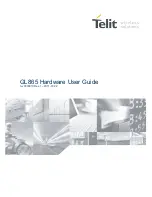
8-9
TIMER/COUNTERS AND WATCHDOG TIMER
8.4.1
Mode 0 (13-bit Timer)
Mode 0 configures timer 0 as a 13-bit timer, which is set up as an 8-bit timer (TH1 register) with
a modulo-32 prescalar implemented with the lower 5 bits of the TL1 register (Figure 8-2). The
upper 3 bits of the TL1 register are ignored. Prescalar overflow increments the TH1 register.
8.4.2
Mode 1 (16-bit Timer)
Mode 1 configures timer 1 as a 16-bit timer with TH1 and TL1 connected in cascade (Figure 8-2).
The selected input increments TL1.
8.4.3
Mode 2 (8-bit Timer with Auto-reload)
Mode 2 configures timer 1 as an 8-bit timer (TL1 register) with automatic reload from the TH1
register on overflow (Figure 8-3). Overflow from TL1 sets overflow flag TF1 in the TCON reg-
ister and reloads TL1 with the contents of TH1, which is preset by software. The reload leaves
TH1 unchanged. See section 8.5.1, “Auto-load Setup Example.”
8.4.4
Mode 3 (Halt)
Placing timer 1 in mode 3 causes it to halt and hold its count. This can be used to halt timer 1
when the TR1 run control bit is not available, i.e., when timer 0 is in mode 3. See the final para-
graph of section 8.4, “Timer 1.”
8.5
TIMER 0/1 APPLICATIONS
Timer 0 and timer 1 are general purpose timers that can be used in a variety of ways. The timer
applications presented in this section are intended to demonstrate timer setup, and do not repre-
sent the only arrangement nor necessarily the best arrangement for a given task. These examples
employ timer 0, but timer 1 can be set up in the same manner using the appropriate registers.
8.5.1
Auto-load Setup Example
Timer 0 can be configured as an eight-bit timer (TL0) with automatic reload as follows:
1.
Program the four low-order bits of the TMOD register (Figure 8-5) to specify: mode 2 for
timer 0, C/T0# = 0 to select F
OSC
/12 as the timer input, and GATE0 = 0 to select TR0 as
the timer run control.
2.
Enter an eight-bit initial value (n
0
) in timer register TL0, so that the timer overflows after
the desired number of peripheral cycles.
Summary of Contents for 8XC251SA
Page 2: ......
Page 3: ...May 1996 8XC251SA 8XC251SB 8XC251SP 8XC251SQ Embedded Microcontroller User s Manual...
Page 18: ......
Page 19: ...1 Guide to This Manual...
Page 20: ......
Page 30: ......
Page 31: ...2 Architectural Overview...
Page 32: ......
Page 41: ...3 Address Spaces...
Page 42: ......
Page 63: ...4 Device Configuration...
Page 64: ......
Page 81: ...5 Programming...
Page 82: ......
Page 102: ......
Page 103: ...6 Interrupt System...
Page 104: ......
Page 120: ......
Page 121: ...7 Input Output Ports...
Page 122: ......
Page 132: ......
Page 133: ...8 Timer Counters and Watchdog Timer...
Page 134: ......
Page 153: ...9 Programmable Counter Array...
Page 154: ......
Page 170: ......
Page 171: ...10 Serial I O Port...
Page 172: ......
Page 187: ...11 Minimum Hardware Setup...
Page 188: ......
Page 197: ...12 Special Operating Modes...
Page 198: ......
Page 206: ......
Page 207: ...13 External Memory Interface...
Page 208: ......
Page 239: ...14 Programming and Verifying Nonvolatile Memory...
Page 240: ......
Page 250: ......
Page 251: ...A Instruction Set Reference...
Page 252: ......
Page 390: ......
Page 391: ...B Signal Descriptions...
Page 392: ......
Page 400: ......
Page 401: ...C Registers...
Page 402: ......
Page 436: ......
Page 437: ...Glossary...
Page 438: ......
Page 446: ......
Page 447: ...Index...
Page 448: ......
Page 458: ......















































